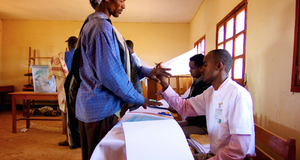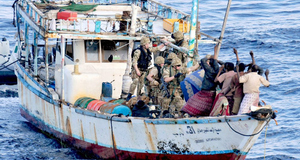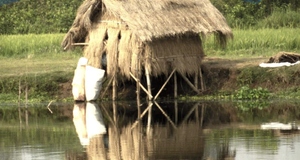Featured Article:State Building in Somalia in the Image of Somaliland: A Bottom-Up ApproachFailure of Western State Building in SomaliaFor the past fourteen years internationally backed and aided governments in Somalia have been able to do little more than exist on paper. Various strongmen attempted to fill the vacuum created by a lack of government and gain access to the foreign aid designed to help legitimize these paper governments. All of these attempts lack a bottom-up and clan legitimized approach to Somali government formation. Ahmed & Green highlight that unlike the internationally backed attempts at state building, “conflict resolution in the north has always been the responsibility of elders who have authority to represent their clans” (Ahmed & Green, 1999, p.123). The ineffectiveness of the transitional governments stems from their “willful mismanagement of public resources” which “prevented the state from being self-supporting” (Leeson, 2007, p.8). Western state building attempts did not focus on a clan or local level: “no constructive attempts were made to engage local networks and mosque-related groups… nor were clan elders recognized as constituting genuine historically rooted community conduits; nor was it realized that by strengthening them, peace lords would have been supported” (Ahmed & Green, 1999, p.123). The overwhelming problem with the transitional governments is that they are not seen as legitimate in the eyes of the Somali people. This deficiency of legitimation stems from the exclusion of actors capable of delivering on a bottom-up approach. Martin Doornbos states, “the issue is neither the provisional government nor the parliament has been recognized by a number of important political groups and stakeholders” (1990, p.93). Byrne believes that a top down solution does not allow for cleavages within Somali politics to be locally reconciled, noting that top down institutions cannot be sensitive to the requirements and structures of society and therefore lack a stable foundation (2013, p.121). In the case of Somalia it can therefore be assumed the social contract between state and citizen is “most likely to occur from the bottom up in irregular forms and with imperfect coverage, rather than imposed from above” (Leonard & Samantar, 2011, p.561). Unlike the internationally backed transitional attempts at Somali government consolidation, the Somaliland approach has been organic in nature. There has been little if any international aid given to these state building projects. Clan elders have been the catalysts for ending violence between clans and sub-clans and providing security for and legitimacy to the government in Somaliland. “A major problem with these high profile affairs (the transitional governments) is that legitimate representatives of the affected communities, such as elders, merchants, women’s groups and other genuine stakeholders, are not included” (Ahmed & Green, 1999, p.124). This lack of legitimation can be seen in the structures of the conferences that transitional governments and organic governments have derived from.By all accounts Somaliland has succeeded where the internationally backed attempts at Somali government have not. The incorporation of Somaliland realized a stable government in the former Somali territory and initiated the building of an organic Somali state from the bottom up. Somaliland has a constitution, a functioning representative government and security forces which protect a defined territory. The population of Somaliland recognizes the government as legitimate and has sent emissaries to foreign capitals, even if those same foreign capitals do not officially recognize the existence of Somaliland for political reasons. How Clan-Based Governance Can Work for SomaliaSomaliland’s claim to sovereignty stems from the fact that in 1960 it was itself an independent state, which freely joined into unification with Italian administered areas of southern Somalia to create the Republic of Somalia. Somaliland asserts that when the government collapsed in 1991 it returned to its independent status after the Conference at Burao, when Clan elders met for a week in the center of Isaaq Somaliland and agreed to six resolutions which would end the civil war in northern Somalia and establish a separate administration from Mogadishu (Walls, 2009, po.379). The territory of Somaliland would encompass Isaaq, Dir and Darod clans and be exactly the same territorially as British Somaliland was at the time of independence. Inter-clan conflict after the Burao conference was successfully resolved by delegations of clan elders from the conflicting groups, proving that conflict resolution on a local level was achievable. “The financial and human cost of the fighting had been high, no attempt would be made to calculate the compensation for people killed or property destroyed” (Walls, 2009, p.379), the dia groups would have to reconcile their differences without compensation, which meant the territory would be in a better position to move forward by removing a long and drawn out reparations process which could potentially return the territory to fighting based on perceived wrongs in compensation cases. “It is notable that the principle of ‘forgetting’ grievances rather than calculating and enforcing compensation payments was applied in each of the Somaliland peace-building processes” (Byrne, 2013, p.121). It is also important to note the unique direction reconciliation takes in the case of Somaliland. The major difference between Somaliland’s reconciliation process and other processes, such as those in South Africa, Northern Ireland, or Guatemala, was the lack of retribution for the victims. In the South African and Guatemalan examples reconciliation followed a course of acknowledgement, giving public recognition to the victims and their families. In these cases the injustices were ostensibly perpetrated under government sanction and acknowledgement was a way of showing government culpability in the infractions against its citizens. The Good Friday Agreement in Northern Ireland took a different approach, providing “only for the release of prisoners, and not for their pardon, the public verdict still stands” (Biggar, 2002, p.177). By allowing for the pardon of criminals the Good Friday Agreement still acknowledges the guilt of perpetrators, but allows breathing room for the healing process by admitting that the prisoners were incarcerated under less than favorable conditions. In all three cases the political solution to the problem was facilitated by some form of government, which was able to broker and enforce not only peace, but also establish recognition of the problems at hand. Somaliland is a different case because the reconciliation clan leaders arranged occurred out of a lack of government, and with the direct intent of creating an environment for government creation to occur. “In a very real sense, the clan elders have served to guarantee peace and security in Somaliland in that they are the nation’s ultimate fallback as an ‘insurance policy’ against descent into anarchy” (Jhazbhay, 2009, p.58). The elders in this case were also able to create an agreement that all sides were able to consider just as well as politically viable. Biggar (2002, p.168) would see this as a successful resolution tactic because “insofar as people regard a political settlement as unjust, they will not support it; and if enough people regard it as unjust, it will cease to be politically viable.” This method of forgetting grievances may not be transferrable to the rest of Somali society, but Walls points out that “it is an option in situations where conflict has been so complex or devastating as to make calculation of dia compensation impossible” (Jhazbhay, 2009, p.177). In order for this kind of tactic to be adopted by southern Somali clans and dia groups there has to be an understanding that the conflict is in fact over, and no return to violence should occur based on previous grievances. This kind of stability enhancing measure is precisely what is needed in the still fractured south. Byrne states that in order “to be stable, any state building in Somalia must account for the devolved nature of Somali society, something less possible with a centralized development focus” (2013, p.120). The development of structural institutions has been at the heart of transitional governments and western interventions for years instead of placing emphasis on clan and dia reconciliation. Somaliland has a twenty-year plan to modernize and solidify government function. A key element of this plan that could be applied to the entire territory of Somalia with great success would be that of decentralization. “Grassroots and civil society participation in the decision making process will be assured through a decentralized system where local communities will decide on the issues that affects them most” (Somaliland National Vision, 2011, p.8). Decentralization of the state government in favor of local districts has worked extremely well in the clan based system. In fact early proponents of Somaliland independence envisioned a future dispensation where power was devolved to the regions (Pham, 2012, p.13) and the structure of the government would be as simple as possible while elevating xeer to establish traditional law and custom to a national level (Jhazbhay, 2009, p.57). This decentralized government allows the clans to retain a level of autonomy which was common under British rule, and present in the south before Italian colonization. Decentralized government would also end a trend started by the Italians of attempting to bring together disparate parts under a strong central government. Advocates of some form of decentralized, federal or even confederal systems claim only a decentralized approach can guarantee to local communities protection from a central state dominated by another lineage (Menkhaus, 2006, p.83). By giving the clans more responsibility in local government, ownership of projects and their results are shared by the communities on a local level. Focusing the ownership of projects at a local level creates strong local government institutions, which become reactive and sensitive to what the citizens need when compared to a top-down western style government imposed by the international community. Decentralization does not come without risks and past evidence of difficult implementation can be found in several examples throughout Africa. In many cases decentralization has proceeded slowly in the wake of overdeveloped post-colonial states which “highly favored centralized systems of government” (Barrett, Mude, and Omiti, 2007, p.1). Proponents of decentralization will argue that it brings government accountability, community empowerment, and efficiency in the use of public services as well as improved local and national governance (Garcia & Sunil, 2008, p.8). The goal in Somaliland is to achieve these objectives while creating a hybrid government sensitive to traditional clan structures. In order for decentralization to be effective, infrastructure; political, social and physical, needs to be in place. Ethiopia has seen federal spending increases going toward basic services in order to effectively implement decentralization accounting for six-percent of the federal budget (Garcia & Sunil, 2008, p.59). Gordon Crawford and Christof Hartmann analyze four decentralization case studies in Ghana, Uganda, Malawi and Tanzania and conclude that none achieved greater government accountability (2008, p.240) and three out of four had generally negative results, only in Tanzania were “outcomes perceived more positively” (Crawford & Hartmann, 2008, p.234). These findings are not exactly a glowing endorsement for the decentralization Somaliland is attempting to undertake. Susan Steiner emphasizes the point that “decentralization is a highly complex reform process” requiring comprehensive changes in political, administrative and fiscal structures (as cited in Crawford & Hartmann, 2008, p.235). It is precisely because these changes occurred within an existing government that they prove to be so difficult and often have less than desirable results. In the cases of Somaliland and the lack of functioning government should provide an excellent point of embarkation for an attempt at creating a stable, functioning and decentralized government. The Somaliland Guurti, or House of Elders, which represents the major clans and ensures balance within the clan system is cited in the Somaliland Constitution as being responsible for “review (of) the legislation passed by the House of Representatives before it is forwarded to the President; and shall have special responsibility for passing laws relating to religion, traditions (culture) and security” (Republic of Somaliland Constitution, 2006, p.21). This places significant power back into the hands of clan elders – members of the Guurti must be 45 years of age or more – who have the experience of the civil war and peacemaking behind them. In 1993, as part of the overall strategy of decentralization of the Somaliland government, the President deferred to the Guurti to assume responsibility for mediating disputes between the government and opposition groups. Walls points out that, “in taking this action, he effectively transferred responsibility for negotiating a transition to civilian government to a traditionally based (and civilian) Guurti” (2009, p.383). The ceding of executive power showed clans that the Somaliland government was not going to be a system similar to previous Somali regimes. Seth Kaplan (2008, p.144) states, “Somaliland’s evolution shows that states should look inward for their resources and institutional models and adopt political structures and processes that reflect the history, complexity, and particularity of their peoples and environments” also Walls (2009, p.386) asserts, “only moving to issues of future conflict management and governance when issues relating to the past have been dealt with or agreement had been reached” allows for a precedent that creates trust and honesty between negotiating groups. These “pragmatic first-level principles” were the basis for clan negotiations in Somaliland and carried a lot of weight toward establishing peace in Somaliland and ending the civil war there. The approaches are also reflective of “traditional concepts of Somali governance by consultation and consent” (Kaplan, 2008, p.144). Joel Samoff uses Tanzania, as an example of the same kind of first level principles at work in creating a consultative and sensitive government in Africa. Coffee revenue in the Kilimanjaro region is extremely important to the markets in a way which gives the region almost outsized influence in the Tanzanian government. This influence stems from educational advantages resulting from high earnings in the area which “enabled its citizens to assume prominent roles and have substantial influence in the national leadership” (Samoff, 1980, p.13) and enabled the proliferation of values and ideas of development beyond the regions borders. Clans are the most important element in Somali society that endured repeated attempts at state building in the wake of colonization and independence. “Different types of local polities have emerged in Somalia, but the most common manifestation has been a coalition of clan elders, intellectuals, (and) businesspeople.” (Menkhaus, 2006, p.85) Consequently clans are the logical unit from which to build a bottom up Somali government. “The principle that each clan should take responsibility for the actions of individuals within that clan’s territory similarly represents a pragmatic application of an established principle of responsibility” (Walls, 2009, p.386) which seems to be lacking in modern Somalia due to the failure of the central state and the failure of the international community to build a new one in its place. “The important distinction” according to Bradbury is that state-building in Somaliland has been “rooted in a popular consensus and embedded in society rather than imposed from above” (as cited in Byrne, 2013, p.121). The reliance on traditional societal norms helps to bring legitimacy to the Somaliland government and fosters a sense of ownership of that government among the people through the power of the clans. Political parties are limited to three by the Somaliland constitution. Some western critics see this as a limiting of the opposition voice and an attempt to centralize the political system in favor of a few clan elites. This is not the case. “Significant political differences encouraged a proliferation of parties to the point where Somalia had more parties per capita than any other democratic country except Israel” in the last multi-party elections in 1969 which were contested by over 60 parties (Ahmed & Green, 1999, p.116). By limiting the number of political parties to three the Somaliland government is adapting to the local realities of Somali politics. Having a three party cap is politically beneficial because it limits the effects of fracturing sub-clan and dia alliances and forces groups to ally themselves in a focused manner. This still allows for dissention against the government, but in a focused way which allows for the development of liberal institutions through political competition. The political parties need to be sensitive to their members in order to be successful. If they are not, the allegiances will shift from one party to another that is more receptive. The number of political parties is roughly reflective of the number of regional clans; in a southern Somalia state-building effort this structure could be mirrored, or even broken into a slightly greater number of parties reflective of a sub-clan structure in order to give greater voice to the population and create a greater sensitivity to local issues and to support a greater base of political needs.Continued on Next Page » Suggested Reading from Inquiries Journal
Inquiries Journal provides undergraduate and graduate students around the world a platform for the wide dissemination of academic work over a range of core disciplines. Representing the work of students from hundreds of institutions around the globe, Inquiries Journal's large database of academic articles is completely free. Learn more | Blog | Submit Latest in Political Science |


















